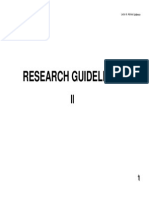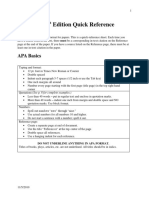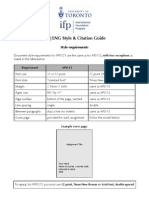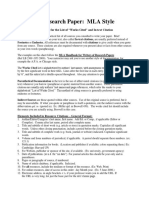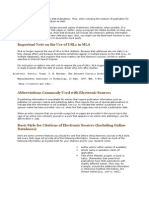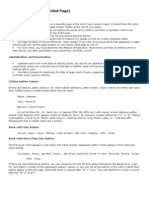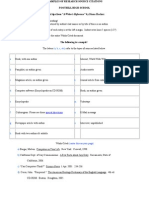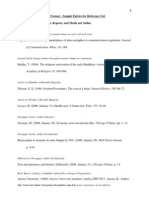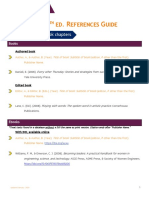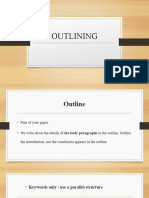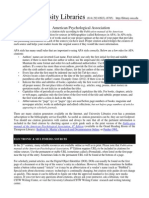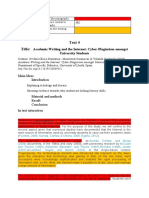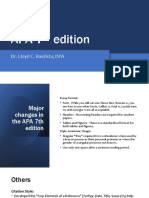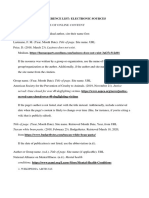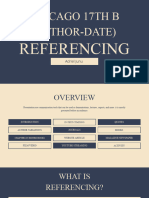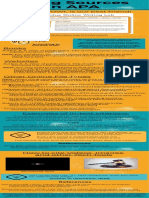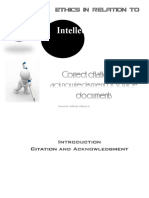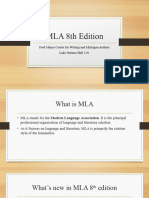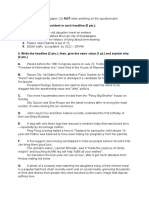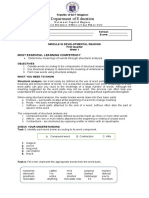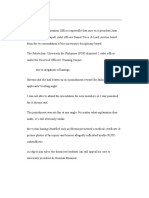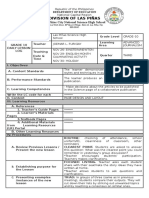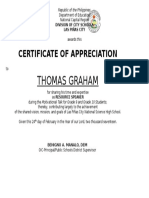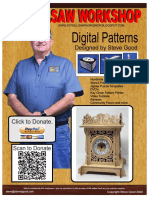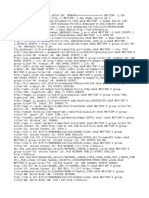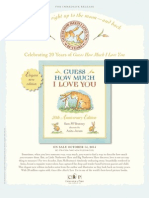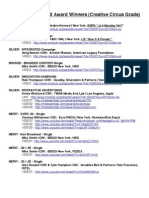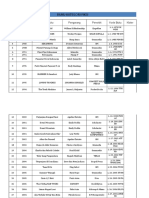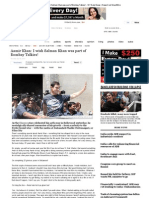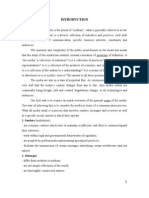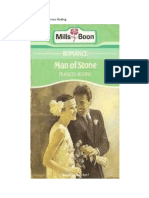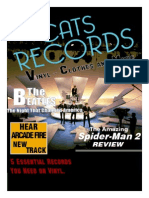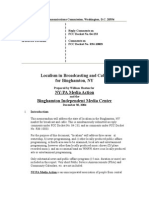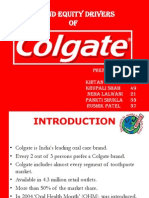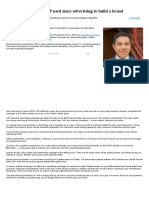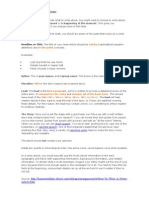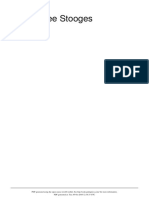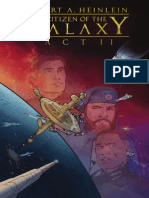Examples for References(APA) or Works Cited (MLA)
NOTE: Engrade formatting does not allow for hanging indents, which you must use for both styles. MLA Style 1. Print sources: A. Book Booth, Wayne C., Gregory G. Colomb, and Joseph M. Williams. The Craft of Research. 2nd ed. Chicago: U of Chicago P, 2003. Print. B. Scholarly journal Williams, Linda. "Of Kisses and Ellipses: The Long Adolescence of American Movies." Critical Inquiry 32.2 (2006): 288-340. Print. Kaminer, Wendy. "The Last Taboo." New Republic 14 Oct. 1996: 24+. Print. [If an article is not printed on consecutive pages, write only the first page number and a plus sign.] C. An anonymous article "The Decade of the Spy." Newsweek. 7 Mar. 1994: 26-27. Print. 2. Online Sources: NOTE: "Electronic texts can be updated easily and at irregular intervals. Any version of a Web source is potentially different from any past or future version and must be considered unique. Scholars therefore need to record the date of access as well as the publication data when citing sources on the Web" (MLA 212). Also, MLA, 7th ed., does not require the Universal Resource Locator (URL) for Web documents. However, some instructors, including me, require that you do Include the URL; enclose the full address in angle brackets followed by a period). For example, <http://www.lcc.hawaii.edu/lib/>. A. Web page Author. "Title." Web Site. Publisher of site, date of publication. Web. Date of Access. <Complete URL>
�B. Periodical in an online database: Model: Author. "Title of Article." Title of Journal vol.issue (year): inclusive page numbers. Title of Database. Web. Date of Access. Botting, Jack H., and Adrian R. Morrison. "Animal Research Is Vital to Medicine." Scientific American. Feb. 1997: 83-85. Google Scholar. Academic Search Complete. Web. 3 Nov. 2008. C. A video from the web: "Web 2.0...The Machine is Us/ing Us." By Michael Wesch. YouTube. YouTube, 31 Jan. 2007. Web. 9 Oct. 2009. <http://www.youtube.com/watch?v=6gmP4nk0EOE>. D. An Interview: Pei, I. M. Personal interview. 22 July 1993. __________________________________________________________________ ___________ APA Style 1. Chapter or part of a larger collection in print: Berndt, T. J. (1996). Exploring the effects of friendship quality on social development. In W. M. Bukowski, A. F. Newcomb, & W. W. Hartup, (Eds.), The company they keep: Friendship in childhood and adolescence. (pp. 346-365). Cambridge, UK: Cambridge University Press. 2. Periodical in print: Berndt, T. J. (2002). Friendship quality and social development. Current Directions in Psychological Science, 11, 7-10. 3. Nonperiodical Internet Document (e.g., a Web page or report): Model: Author, A. A., & Author, B. B. (Date of publication). Title of article. Retrieved month date, year, from http://Web address. Model: Author, A. A., & Author, B. B. (Date of publication). Title of article. In Title
�of book or larger document (chapter or section number). Retrieved from http://Web address.
Comparing In-text Citations: MLA and APA
Student paragraph What is important is that the public or customers have the right to know about the product theyre about to buy. They have the right to expect that the information that accompanies the product is honest and clear. Also, pg. 24 mentions that an organization is acting ethically if its products or services are safe and effective. They must not injure or harm consumers, and they must fulfill their promised functions. The public has the right to be sure that they wont be harmed by the product.
MLA Style
In-text citation: What is important is that the public or customers have the right to know about the product theyre about to buy. Ethicist Manuel Velasquez argues that consumers have the right to expect that the information that accompanies the product is honest and clear (qtd. in Markel 24). According to Mike Markel, author of Technical Communication, an organization is acting ethically if its products or services are safe and effective. They must not injure or harm consumers, and they must fulfill their promised functions (24). The public has the right to be sure that they wont be harmed by the product. Works Cited entry: Markel, Mike. Technical Communication. 9th ed. Boston, MA: Bedford/St.Martins, 2010. Print.
APA Style
�In-text citation: What is important is that the public or customers have the right to know about the product theyre about to buy. Ethicist Manuel Velasquez (2006) argues that consumers have the right to expect that the information that accompanies the product is honest and clear (as cited in Markel, 2010, p. 24). According to Mike Markel, author of Technical Communication, an organization is acting ethically if its products or services are safe and effective. They must not injure or harm consumers, and they must fulfill their promised functions (24). The public has the right to be sure that they wont be harmed by the product. References entry: Markel, M. (2010). Technical communication (9th ed). Boston, MA: Bedford/St.Martins.
APA Guidelines
Download these basic guidelines for using APA in citations. Download these basic guidelines for using MLA in citations.
Incorporating Sources
Examples of Incorporating Source Material
Student Citation # 1 I am seeking approval to research the growing need of e-readers on a college campus and the differences in the popular types. Preliminary research is made up of a survey about the number of students that use an e-reader and the amount of time that device is used on a regular basis. It is also made up of articles about the growth of e-readers on college campuses and in many public libraries around the country, see the following insert for example: According to an article about e-readers in public libraries, I think the general trend is we're seeing an increase in the number of readers who are using e-books," said
�Maureen Sullivan, president of the Chicago-based American Library Association. "That is creating for libraries a need to be sure we can offer the book that we would make available in print also (available) in the e- book format." (Gillian 2012) Revised Citation #1: I am seeking approval to research the growing need for e-readers on a college campus and the differences in the popular types. Preliminary research suggests a growing demand for e-readers on college campuses and in many public libraries around the country. Maureen Sullivan, president of the Chicago-based American Library Association, said, I think the general trend is we're seeing an increase in the number of readers who are using e-books. That is creating for libraries a need to be sure we can offer the book that we would make available in print also (available) in the e- book format." (Gillian 2012) __________________________________________________________________ ______________ Student Citation # 2 (clearly plagiarism-see the original source below the revision) I feel that the use of e-readers on college campuses could increase the number of students who actually use textbooks. Many companies such Itunes now have a whole new application available strictly for e-books called Itunes U. The accounting major at Virginia State University got by in several courses with study groups and professors' lectures. "It's not that I didn't want to buy," he says. "Sometimes, I just didn't have the money for a $200 book." VSU, a 129-year-old historically black college in Petersburg, Va., knows Martin isn't the only one. More than half of its students routinely skip buying textbooks. (Yu 2012) use more paraphrase and less direct quotation so that what is borrowed and what is original is clearer. Revised Citation #2: This revision more clearly states the focus on the digital and financial parts of the problem and provides a smoother and more honest integration of the source material. E-readers on college campuses may not only better accommodate students digital
�lifestyles; they may also encourage more students to actually use their textbooks and save money doing so. Many companies such as Itunes now have applications available strictly for e-books; Itunes is called Itunes U. In an article for USAToday, Roger Yu (Yu 2012) describes one universitys solution to the growing problem of textbook costs for many students. Like many college students today, Martin, an accounting major at Virginia State University, relies only on study groups and professors' lectures for some courses. "It's not that I didn't want to buy," he says. "Sometimes, I just didn't have the money for a $200 book." Yu reports that more than half of the students at VSU dont buy textbooks. In a pilot program, the college, supported by a local grant, is providing e-textbooks for students in select business courses (Yu). Original Source: Textbooks are often a luxury for college senior Vatell Martin. The accounting major at Virginia State University got by in several courses with study groups and professors' lectures. "It's not that I didn't want to buy," he says. "Sometimes, I just didn't have the money for a $200 book." VSU, a 129-year-old historically black college in Petersburg, Va., knows Martin isn't the only one. More than half of its students routinely skip buying textbooks. For a solution, the school is turning to e-textbooks. VSU partnered with Flat World Knowledge, a start-up publisher that produces exclusively written e-books with "open" content that can be modified by professors. In a trial with 14 business courses, students would be required to pay $20 and receive a Flat World e-book and digital learning supplements. (The university and a local grant have been covering the cost, so far.)

